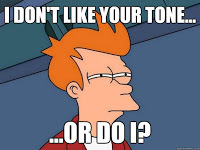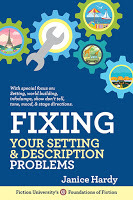Leave a Message at the Tone: Setting the Right Tone for Your Novel
 By Janice Hardy, @Janice_Hardy
By Janice Hardy, @Janice_HardyTone is an important part of any story. The wrong tone can ruin the mood and steal the thunder away from the words.
There's a great moment in the beginning of Pirates of the Caribbean where Captain Jack Sparrow is standing in the crow's nest as his ship pulls into port. It has a big adventure feel, the mighty pirate surveying his domain. Then, as the camera pulls away, you see his ship is sinking and it goes under just as he reaches the dock and steps off.
It's silly, it's comical, and it immediately sets the tone for the rest of the movie. We’re not taking ourselves too seriously, here.
Which is exactly right for a movie based on a ride at Disney World.
The scene is a bit over the top, but but it informs viewers right away to just go with it and enjoy the ride. It's all about fun, not a realistic look at pirates. You know what you're going to get after that, so anytime the movies gets a little silly you accept it.
The tone you set in your novel will inform your readers the same way. Start out silly when your novel gets dark after Chapter One, and readers won’t be happy with the sudden switch. Start dark when it’s a light, fun romp and your readers won’t ever get past the first scene.
(Here's more on How the Wrong Tone Can Change Your Whole Novel)
Here are some ways to set the right tone in your novel.
Use the Right Imagery for the Tone You Want to Evoke
Description is a big part of any novel, and the images you choose set not only the scene, but the tone of that scene.
For example, if you want tragic, yet hopeful, use images with contradictory details that support that. Flowers blooming in garbage. Kids playing in the ruins of a bombed out apartment building. Think about things that convey hope and overlay them on tragedy. Sunbeams breaking through the dark clouds. Determination on someone's face. Whatever suits your setting and story.
If you’re going for scary or foreboding, use images with dark connotations. Shadows and night, decay, items deteriorating. Perhaps show things on the edge of falling, such as a stack of dishes about to topple over, or pictures hanging on a bent nail. The suggestion of something about to break.
(Here’s more on Intuiting Your Character: A Guided Imagery Exercise)
Choose Words that Convey the Emotion You Need
Writing is word painting, so make the most of the language. What words are usually associated with the emotion you want to create? But don’t just pull the first words that come to mind—everyone uses those. Dig deeper and find emotional words that best suit your story and characters.
Crying is typically associated with sadness, yet people cry when they're happy, scared, or frustrated as well. Crying while smiling sets a mood that's different from crying while frowning. “She wanted to die” evokes a different emotional tone than “She gripped the knife and held it to her wrist.” The second version creates a much more visceral reaction.
You can also try juxtaposing emotional keywords so they evoke the tone and mood you want. A man in love might think about what a wonderful day it is, even though it’s a torrential downpour and he’s soaked to the skin. But if that storm reminds him of his love, that rain may patter and splash instead of pound and drench.
(Here’s more on Do You Think He Likes Me? Conveying Emotions in Your Novel)
Choose a Rhythm that Supports the Tone
The rhythm of the sentences can affect the emotional state of readers as they read. When sentences speed up, so does their heart. When sentences are long and languid, they lull readers as well.
Banter is typically fast-paced with short sentences, using little or no exposition or tags with the dialogue. It's light and funny, and it sets a tone of teasing or playfulness.
Anger is often conveyed with choppy sentences, sudden starts and stops as people yell, then pause to think and yell again. It’s rough and sometimes agitating to read, which fits the emotion well.
Sadness is often drawn out, using longer, slower sentences and lots of internalization. But it might also have short one or two-word sentences to punctuate that sadness.
Think about the beats of the words as if they were poetry. Ending on a downbeat can signify sadness, while an upbeat can indicate happiness.
(Here’s more on Feel the Rhythm of the Words)
Make Sure Your Characters Match the Tone
 No matter how serious a situation is, if the point of view character is flippant and blows it off, it won't feel serious. Same as how a character being overly dramatic in a situation that clearly doesn't call for it can feel melodramatic.
No matter how serious a situation is, if the point of view character is flippant and blows it off, it won't feel serious. Same as how a character being overly dramatic in a situation that clearly doesn't call for it can feel melodramatic. Readers are going to take their clues from the characters, so unless the point is to show the characters have no clue what’s really going on, their emotional states will likely mimic or suit the tone of the scene.
How a character feels will also encourage readers to feel the same way. If the scene calls for happy and light, and the protagonist is happy and playful, readers will likely feel that happiness and smile as well. If the scene is fraught with danger and the tone suggests this is where it all goes wrong, readers will feel that tension and worry along with the character.
(Here’s more on Crafting Emotion: The Importance of Matching Actions To Feelings)
Tone can set a mood and turn a setting into more than just scenery. Think of it as the soundtrack if your story. What kind of music do you want playing in the background?
What tone(s) are you setting in your current novel?
*Originally published January 2011. Updated August 2019.
Find out more about setting and description in my book, Fixing Your Setting & Description Problems.
 Go step-by-step through setting and description-related issues, such as weak world building, heavy infodumping, told prose, awkward stage direction, inconsistent tone and mood, and overwritten descriptions. Learn how to analyze your draft, spot any problems or weak areas, and fix those problems.
Go step-by-step through setting and description-related issues, such as weak world building, heavy infodumping, told prose, awkward stage direction, inconsistent tone and mood, and overwritten descriptions. Learn how to analyze your draft, spot any problems or weak areas, and fix those problems. With clear and easy-to-understand examples, Fixing Your Setting & Description Problems offers five self-guided workshops that target the common issues that make readers stop reading. It will help you:
Choose the right details to bring your setting and world to lifeCraft strong descriptions without overwriting Determine the right way to include information without infodumpingCreate compelling emotional layers that reflect the tone and mood of your scenesFix awkward stage direction and unclear character actions Fixing Setting & Description Problems starts every workshop with an analysis to pinpoint problem areas and offers multiple revision options in each area. You choose the options that best fit your writing process. It's an easy-to-follow guide to crafting immersive settings and worlds that draw readers into your story and keep them there.
Available in paperback and ebook formats.
 Janice Hardy is the award-winning author of the teen fantasy trilogy The Healing Wars, including The Shifter, Blue Fire, and Darkfall from Balzer+Bray/Harper Collins. The Shifter, was chosen for the 2014 list of "Ten Books All Young Georgians Should Read" from the Georgia Center for the Book.
Janice Hardy is the award-winning author of the teen fantasy trilogy The Healing Wars, including The Shifter, Blue Fire, and Darkfall from Balzer+Bray/Harper Collins. The Shifter, was chosen for the 2014 list of "Ten Books All Young Georgians Should Read" from the Georgia Center for the Book. She also writes the Grace Harper urban fantasy series for adults under the name, J.T. Hardy.
When she's not writing novels, she's teaching other writers how to improve their craft. She's the founder of Fiction University and has written multiple books on writing. Website | Facebook | Twitter | Pinterest | Goodreads | Amazon | Barnes & Noble | iTunes | Indie BoundWritten by Janice Hardy. Fiction-University.com
Published on August 28, 2019 04:01
No comments have been added yet.



